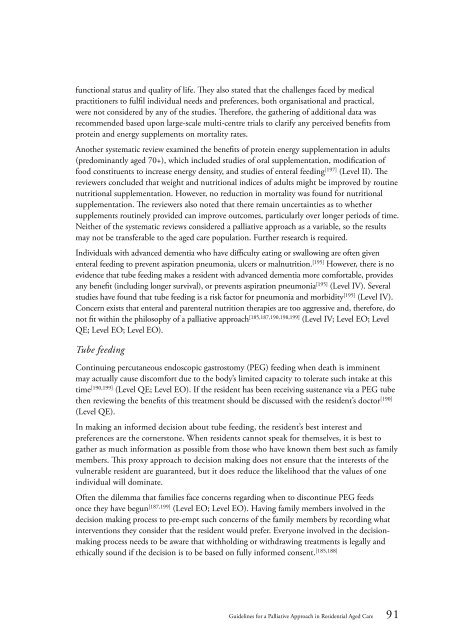Guidelines for a Palliative Approach in Residential Aged Care
Guidelines for a Palliative Approach in Residential Aged Care
Guidelines for a Palliative Approach in Residential Aged Care
You also want an ePaper? Increase the reach of your titles
YUMPU automatically turns print PDFs into web optimized ePapers that Google loves.
functional status and quality of life. They also stated that the challenges faced by medical<br />
practitioners to fulfil <strong>in</strong>dividual needs and preferences, both organisational and practical,<br />
were not considered by any of the studies. There<strong>for</strong>e, the gather<strong>in</strong>g of additional data was<br />
recommended based upon large-scale multi-centre trials to clarify any perceived benefits from<br />
prote<strong>in</strong> and energy supplements on mortality rates.<br />
Another systematic review exam<strong>in</strong>ed the benefits of prote<strong>in</strong> energy supplementation <strong>in</strong> adults<br />
(predom<strong>in</strong>antly aged 70+), which <strong>in</strong>cluded studies of oral supplementation, modification of<br />
food constituents to <strong>in</strong>crease energy density, and studies of enteral feed<strong>in</strong>g [197] (Level II). The<br />
reviewers concluded that weight and nutritional <strong>in</strong>dices of adults might be improved by rout<strong>in</strong>e<br />
nutritional supplementation. However, no reduction <strong>in</strong> mortality was found <strong>for</strong> nutritional<br />
supplementation. The reviewers also noted that there rema<strong>in</strong> uncerta<strong>in</strong>ties as to whether<br />
supplements rout<strong>in</strong>ely provided can improve outcomes, particularly over longer periods of time.<br />
Neither of the systematic reviews considered a palliative approach as a variable, so the results<br />
may not be transferable to the aged care population. Further research is required.<br />
Individuals with advanced dementia who have difficulty eat<strong>in</strong>g or swallow<strong>in</strong>g are often given<br />
enteral feed<strong>in</strong>g to prevent aspiration pneumonia, ulcers or malnutrition. [195] However, there is no<br />
evidence that tube feed<strong>in</strong>g makes a resident with advanced dementia more com<strong>for</strong>table, provides<br />
any benefit (<strong>in</strong>clud<strong>in</strong>g longer survival), or prevents aspiration pneumonia [195] (Level IV). Several<br />
studies have found that tube feed<strong>in</strong>g is a risk factor <strong>for</strong> pneumonia and morbidity [195] (Level IV).<br />
Concern exists that enteral and parenteral nutrition therapies are too aggressive and, there<strong>for</strong>e, do<br />
not fit with<strong>in</strong> the philosophy of a palliative approach [185,187,190,198,199] (Level IV; Level EO; Level<br />
QE; Level EO; Level EO).<br />
Tube feed<strong>in</strong>g<br />
Cont<strong>in</strong>u<strong>in</strong>g percutaneous endoscopic gastrostomy (PEG) feed<strong>in</strong>g when death is imm<strong>in</strong>ent<br />
may actually cause discom<strong>for</strong>t due to the body’s limited capacity to tolerate such <strong>in</strong>take at this<br />
time [190,199] (Level QE; Level EO). If the resident has been receiv<strong>in</strong>g sustenance via a PEG tube<br />
then review<strong>in</strong>g the benefits of this treatment should be discussed with the resident’s doctor [190]<br />
(Level QE).<br />
In mak<strong>in</strong>g an <strong>in</strong><strong>for</strong>med decision about tube feed<strong>in</strong>g, the resident’s best <strong>in</strong>terest and<br />
preferences are the cornerstone. When residents cannot speak <strong>for</strong> themselves, it is best to<br />
gather as much <strong>in</strong><strong>for</strong>mation as possible from those who have known them best such as family<br />
members. This proxy approach to decision mak<strong>in</strong>g does not ensure that the <strong>in</strong>terests of the<br />
vulnerable resident are guaranteed, but it does reduce the likelihood that the values of one<br />
<strong>in</strong>dividual will dom<strong>in</strong>ate.<br />
Often the dilemma that families face concerns regard<strong>in</strong>g when to discont<strong>in</strong>ue PEG feeds<br />
once they have begun [187,199] (Level EO; Level EO). Hav<strong>in</strong>g family members <strong>in</strong>volved <strong>in</strong> the<br />
decision mak<strong>in</strong>g process to pre-empt such concerns of the family members by record<strong>in</strong>g what<br />
<strong>in</strong>terventions they consider that the resident would prefer. Everyone <strong>in</strong>volved <strong>in</strong> the decisionmak<strong>in</strong>g<br />
process needs to be aware that withhold<strong>in</strong>g or withdraw<strong>in</strong>g treatments is legally and<br />
ethically sound if the decision is to be based on fully <strong>in</strong><strong>for</strong>med consent. [185,188]<br />
<strong>Guidel<strong>in</strong>es</strong> <strong>for</strong> a <strong>Palliative</strong> <strong>Approach</strong> <strong>in</strong> <strong>Residential</strong> <strong>Aged</strong> <strong>Care</strong> 91
















